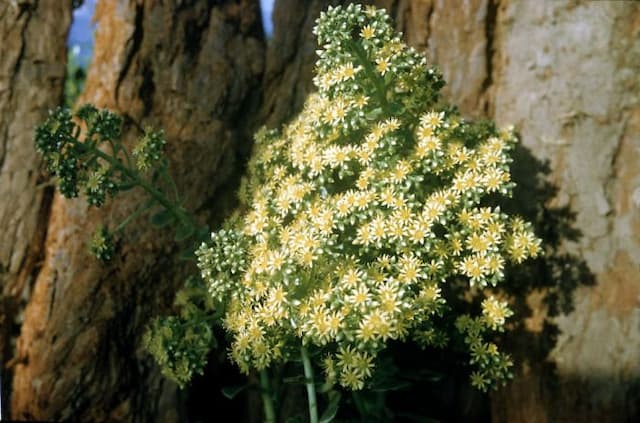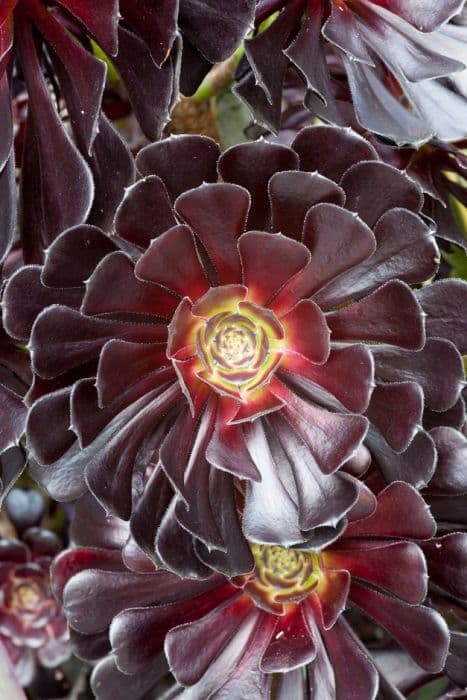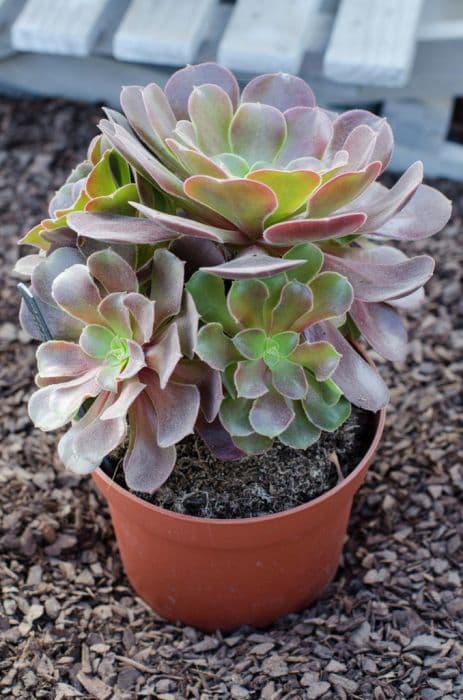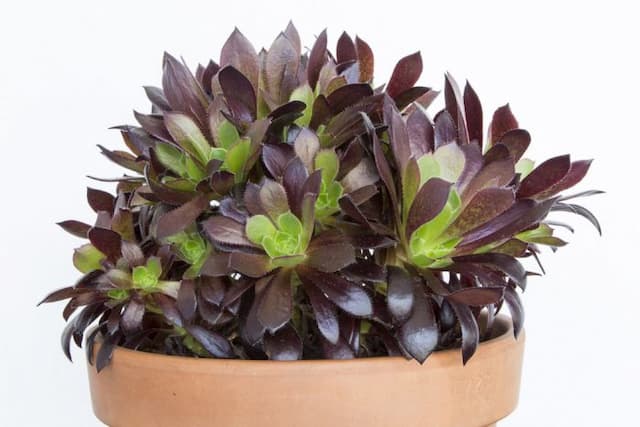Munstead Red Sedum Hylotelephium 'Munstead Red'

ABOUT
Hylotelephium 'Munstead Red', commonly known as the Stonecrop, showcases a striking appearance that is characterized by its robust, succulent foliage and vibrant floral displays. The leaves of Stonecrop are fleshy and often have a waxy coating, which contributes to their ability to withstand dry conditions. These typically exhibit a rich, blue-green color that provides a lush backdrop for the plant's flowers. The flowers of 'Munstead Red' emerge as clustered bunches atop sturdy stems, standing out with an eye-catching red hue. These small, star-shaped blossoms are densely packed together, forming a domed or flat-topped shape that is visually appealing throughout its blooming season. The warm red color of the flowers can vary in intensity and is especially lively when the plant is basking in full sun. Stonecrop flowers not only add a vibrant splash of color to the garden, but they also attract pollinators such as bees and butterflies, adding to the dynamic nature of the plant's display. The combination of the succulent leaves and the richly colored flowers make 'Munstead Red' a favorite among gardeners looking to add a touch of vivid, low-maintenance beauty to their landscapes.
About this plant
 Names
NamesFamily
Crassulaceae
Synonyms
Munstead Red Sedum
Common names
Sedum 'Munstead Red'.
 Toxicity
ToxicityTo humans
The most common common name for Hylotelephium 'Munstead Red' is "Stonecrop." Stonecrop is generally considered non-toxic to humans. If ingested, it is unlikely to cause poisoning. However, as with any plant material, individual sensitivities can vary, and ingesting plant parts may cause minor gastrointestinal discomfort in sensitive individuals.
To pets
The most common common name for Hylotelephium 'Munstead Red' is "Stonecrop." Stonecrop is generally not toxic to pets. It is typically safe around cats and dogs, and there are no widespread reports of severe poisoning from its ingestion. However, if a pet were to consume a large cantidad of the plant, they might experience mild gastrointestinal upset, including symptoms like nausea, vomiting, or diarrhea.
 Characteristics
CharacteristicsLife cycle
Perennials
Foliage type
Deciduous
Color of leaves
Green
Flower color
Red
Height
1-2 feet (30-60 cm)
Spread
1-2 feet (30-60 cm)
Plant type
Succulent
Hardiness zones
3-9
Native area
Asia
Benefits
 General Benefits
General Benefits- Drought Tolerance: Stonecrop is highly drought-tolerant once established, making it suitable for xeriscaping or low-water gardens.
- Easy Maintenance: It requires minimal care, making it ideal for busy or novice gardeners.
- Attracts Pollinators: The flowers attract bees, butterflies, and other pollinating insects, supporting local ecosystems.
- Seasonal Interest: Stonecrop provides vibrant color and texture from late summer through fall, when many other plants have faded.
- Cold Hardy: This plant can survive in cold climates, down to USDA hardiness zone 3, making it a good choice for northern gardens.
- Versatile Landscaping Use: Stonecrop can be used in rock gardens, borders, ground covers, and container gardens.
- Propagates Easily: It can be propagated by cuttings or division, making it easy to spread around the garden or share with friends.
- Deer Resistant: Stonecrop is generally resistant to grazing by deer, sparing it from wildlife damage in prone areas.
- Soil Adaptability: It's adaptable to a range of soil conditions, although it prefers well-draining soil.
 Medical Properties
Medical PropertiesThis plant is not used for medical purposes.
 Air-purifying Qualities
Air-purifying QualitiesThis plant is not specifically known for air purifying qualities.
 Other Uses
Other Uses- Photography and Art Subjects: The rich red hues and striking form of the 'Munstead Red' sedum make it a popular choice for photographers and artists looking to capture its beauty in their work.
- Educational Tool: Botany teachers and educators might use this plant to teach about drought-tolerant species and succulent care in gardening classes.
- Culinary Garnish: Although not widely recognized for culinary use, the flowers can occasionally be used to add a splash of color to gourmet dishes as an edible garnish.
- Livestock Feed: In situations of fodder scarcity, sedum species can sometimes be used as emergency feed for livestock, despite not being a conventional choice.
- Erosion Control: The dense growth habit of 'Munstead Red' can help stabilize soil and prevent erosion on slopes and banks in gardens and landscaping projects.
- Floral Arrangements: Fresh or dried, the flowers of 'Munstead Red' add texture and depth to bouquets and floral decorations.
- Outdoor Crafting: The succulent leaves and stems can be used in crafting outdoor wreaths or decorations, due to their hardiness and longevity.
- Seasonal Celebrations: With its striking autumnal color, 'Munstead Red' is often used in fall garden displays and arrangements for harvest-themed events.
- Green Roof Planting: Because of its low maintenance and drought tolerance, 'Munstead Red' is suitable for planting on green roofs, where it can thrive with minimal care.
- Mood Enhancer: The vibrant color and lush appearance of the sedum can help boost mood and create a sense of wellbeing when used in garden settings.
Interesting Facts
 Feng Shui
Feng ShuiThe Sedum 'Munstead Red' is not used in Feng Shui practice.
 Zodiac Sign Compitability
Zodiac Sign CompitabilityThe Sedum 'Munstead Red' is not used in astrology practice.
 Plant Symbolism
Plant Symbolism- Survival and Resilience: As a species of stonecrop, Munstead Red is known for its ability to thrive in harsh conditions, symbolizing the strength to survive and prosper despite adversity.
- Long-lasting Love: With its enduring and robust nature, Munstead Red can also be seen as a symbol of long-lasting love and commitment, much like the hardy nature of the plant itself.
- Vitality: The vibrant red color of Munstead Red's flowers can symbolize vitality and energy, representing a lively spirit and good health.
- Peace and Tranquility: Often utilized in gardens for its calming presence, the Munstead Red stonecrop may also represent peace and tranquility, offering a sense of calm in the landscape.
 Water
WaterSedum 'Munstead Red' prefers a moderate amount of water with a thorough soaking once every 1-2 weeks, depending on weather conditions. Ensure the soil is dry between waterings to prevent root rot. During the growing season, you might need to water more frequently, especially if the weather is particularly hot or dry. In contrast, reduce watering in the winter months when the plant is dormant. A good approach is to provide about one gallon of water for an outdoor plant of average size, ensuring the water penetrates deeply into the soil.
 Light
LightSedum 'Munstead Red' thrives in full sun to partial shade. It performs best in a location where it can get at least 6 hours of sunlight daily. When positioning the plant, choose a spot that is well-lit for most of the day to encourage strong growth and vibrant blooms.
 Temperature
TemperatureSedum 'Munstead Red' is cold-hardy and can tolerate temperatures as low as 5°F but thrives in temperatures ranging between 60°F and 70°F during the growing season. Avoid exposing it to extremes of heat or cold, as this may damage the plant or inhibit growth.
 Pruning
PruningSedum 'Munstead Red' should be pruned to remove dead or damaged foliage and to maintain its shape. Pruning is best done in the early spring before new growth begins. This plant can also be pruned after flowering to encourage a second bloom. Prune the plant lightly to promote a compact, bushy form and to remove any faded flowers or seed heads.
 Cleaning
CleaningAs needed
 Soil
SoilSedum 'Munstead Red' thrives in well-draining soil with a neutral to slightly alkaline pH around 6.0 to 7.5. A mix of potting soil, coarse sand, and perlite or pumice can provide the excellent drainage this succulent requires.
 Repotting
RepottingSedum 'Munstead Red' generally needs repotting every 2-3 years or when it outgrows its container to prevent it from becoming root-bound and to refresh the soil.
 Humidity & Misting
Humidity & MistingSedum 'Munstead Red' prefers low to average humidity levels and does not require high humidity, which is conducive to its hardy and drought-tolerant nature.
 Suitable locations
Suitable locationsIndoor
Place in bright light, water sparingly.
Outdoor
Full sun, well-drained soil, minimal water.
Hardiness zone
3-9 USDA.
 Life cycle
Life cycleThe life of Hylotelephium 'Munstead Red', commonly known as Stonecrop 'Munstead Red', begins with seed germination, typically taking place in warm, moist soil conditions. Seedlings emerge and establish a root system, followed by the development of succulent leaves and a sturdy stem. As the plant matures, it enters a vegetative growth phase where it expands both its root and foliage mass. Once mature, typically in late summer to early fall, the plant produces clusters of small, star-shaped red flowers which attract pollinators. After flowering, Stonecrop sets seed which can be dispersed by wind or wildlife, completing the reproductive cycle. Over winter, the plant may die back to its root system, especially in colder climates, and then regrow the following spring, continuing its perennial life cycle.
 Propogation
PropogationPropogation time
Early spring
Hylotelephium 'Munstead Red', commonly known as Stonecrop, is best propagated through stem cuttings, particularly in late spring or early summer when the plant’s growth is most vigorous. To propagate, a healthy stem is chosen and a cutting of around 3 to 4 inches is snipped off just above a leaf node. The cut end is then allowed to callous over for a few days to prevent rot when planted. The calloused cutting is then inserted into well-draining soil mix and kept moist but not waterlogged. With adequate sunlight and warmth, the cutting should root within a few weeks, after which it can be treated as a mature plant. This method capitalizes on the plant's natural ability to root easily from its succulent stems and is popular due to its simplicity and high success rate.









